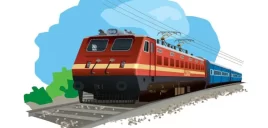Broad Gauge – 5’6″ (1676mm)
This is now found all over the country, and all major passenger and freight routes are now broad gauge. This is the widest gauge in regular use anywhere in the world. (In the past, though, an 8′ gauge was used in Oregon, USA, and a 7’¼” gauge was used for the Great Western Railway in the UK.) Outside India, the 5’6″ gauge is found in Pakistan, a spur from Pakistan into Iran, Sri Lanka, Bangladesh, Argentina, Chile, and the BART rapid transit system in the USA. The decision to use a gauge wider than the one in use in Great Britain was made with an eye towards economies in freight movement, and also to ensure stability in the face of Indian weather and the perceived threat of cyclonic winds.
Meter Gauge – 1m
This is still found in a lot of places, despite the push to convert everything to broad gauge. It is said that this gauge was chosen by Lord Mayo (then Viceroy of India) based on calculations to allow 4 persons to sit comfortably abreast — it would have been 3’3″ except that there was then a push to move to the metric system and so the gauge became 1m. The first MG line was built in 1872 from Delhi to Farukh Nagar (??). Interestingly, the metric system was not after all adopted until nearly a century later, so the gauge was the only thing in India that was ‘metric’ for a very long time.
About 14,500 route km of IR’s network are meter-gauge [2/09] (the figure was about 17,000 route km in 2000). By 2014, MG route-kilometerage is expected to drop to 5,000km or less. The MG network was especially dense in the west (around Vadodara, and in Rajasthan), in the east / north-east (West Bengal, Assam) and, before Independence, the areas in what is now Bangladesh), and in much of the south of India. Until the late 1980s, the North-Eastern Railway had a completely MG network. The MG networks of northern India (including the north-east via the Assam Rail Link) and southern India (16,690 and 7940 route kms, respectively) remained separate until 1960, when the completion of the Khandwa – Hingoli section connected the two. This link went through Akot, Akola, and Basim, across the Tapti and Purna rivers and had 2 tunnels and 50 major bridges, and a spectacular spiral. This made possible the transit of freight from any MG station in India to any other (except, of course, the Nilgiri line which was always an isolated MG section), which was important even though MG’s share of freight was never very large (about 12% before the Unigauge project started). The last MG line to be built in India was probably the Himmatnagar – Udaipur line.
In 1994, the gauge conversion of the Secunderabad – Mahboobnagar broke an important MG freight route connecting the northern and southern MG networks. Then in 1995, the gauge conversion work on the Purna – Mudkhed section completely broke the north–south connections of the MG network. (This has also left [1/01] an isolated MG spur from Secunderabad to Mudkhed. The Secunderabad-Jaipur Exp. runs in 3 portions, an MG one from Secunderabad to Mudkhed, a BG portion from Mudkhed to Purna, and a final MG portion from Purna.) In 2004, work began on the BG conversion of the Purna-Akola section (then planned to be completed by 2006-2007). [1/06] As a result of the conversion work in progress, in early 2006 the longest MG section in India was probably Purna – Akola – Khandwa – Mhow – Ratlam – Ajmer – Jaipur – Rewari. [11/06] Ajmer – Ratlam gauge conversion is scheduled to be done by March 2007 and the Purna-Hingoli section will be closed from Dec. 15, 2006. Ratlam – Khandwa gauge conversion has not yet been scheduled. [2008] The Purna-Hingoli-Akola section was re-opened as a BG line on Nov. 12, 2008.
There are many sections which were converted from BG to MG, and then back again to BG (Guntakal-Bellary, Haldibari-Raninagar, etc.) and if one probes the evolution of some lines, even more tortured multiple conversion histories may be found.
Because of the push to convert MG to BG, IR has practically stopped all MG track renewals and acquisition of MG wagons and coaches since several years ago. An order for MG wagons was placed in 2005 but subsequently cancelled. But there are a few relatively new MG sections (see below).
New MG Lines Despite the Unigauge policy, there are some rare instances of new meter gauge lines or extensions having been constructed recently in the north-east, the most prominent example being the Agartala-Dharmanagar network. Examples include Dharmanagar – Kumarghat was built in 1986-1990, Silchar – Jiribam in 1990, Lala Bazar – Bhairabi in 1988-1991, Balipara – Bhalukpong in 1989-1990.
List of MG routes
Narrow Gauge – 2’6″ (762mm)
This gauge was adopted in various parts of the British Empire. There were (still are) considerable networks of these, for example in Gujarat around Vadodara (mostly from the old Baroda State Railway) and in MP (centred around Gondia on the S.E.R.). (Gondia-Jabalpur Satpura NG railway lines were closed in 2003 and converted to BG.) The most well-known line is probably the Kalka–Shimla route. The rationale for the narrower gauges was economy in building the lines — they could be laid much faster than broad gauge lines and in more difficult terrain. It was envisioned that narrow gauge lines would act as feeder lines to the broad gauge and meter gauge lines, but many became important railway routes in their own right.
Interestingly, there were (are?) even passenger coaches with sleeping accommodations on this gauge, used on the Jabalpur-Gondia, Jabalpur-Nagpur, and Latur-Kuruduwadi sections. The Indian 2’6″ lines are notable in having a loading gauge only marginally smaller than that of the MG lines.
List of NG routes
Narrow Gauge – 2′ (610mm)
A few places in India have the even narrower 2–foot gauge: New Jalpaiguri-Darjeeling, Neral Matheran, and the Gwalior branch lines, which include Gwalior – Sheopur Kalan, Gwalior – Shivpuri, and Gwalior – Bhind. (The Gwalior lines in the past also included the Ujjain–Agar line.) The Howrah-Amta and Howrah-Sheakhala NG lines were shut down a while back, and are now being rebuilt as broad gauge.
The two narrow gauges together make up about 3700 route km of IR’s network.
Interestingly, India has never used ‘rollbocken’ or transporter wagons to allow direct movement of freight from one gauge to another. Transshipment of freight from one gauge to another was always done by manually unloading and reloading the goods from one train to another. Two transporter wagons were supplied by Calthrop to the Barsi Light Railway but fell into disuse after just a few years. They were used at the Kuruduwadi workshops for many years afterwards. Apart from these, no transporter wagons are known to have been used in India.
List of NG routes
Other Indian Gauges
One of the early lines in Bengal (Nalhati–Azimganj, a 40km feeder section connecting to EIR, built in 1863 by the Indian Branch Railway Co.), was initially built to 4′ gauge and then converted to BG.
A 3’6″ (1067mm) gauge has been used in some places, including the industrial network used by the West Bokaro Collieries, Chirmir Collieries at Ballarpur, and for an Arakkonam – Kanchipuram (then spelled Arconum–Conjeverum) line built by the erstwhile Indian Tramways Company in 1865.
A 3′ (914mm) gauge was used by the Tata Iron & Steel Co.
Bengal Coal, at Calcutta, had some 2’2″ (660mm) tracks and 4 locomotives that ran on them in the 1880’s.
In about 1910, Burocher collieries in Bengal had a 1’6″ (457mm) gauge system, the only such in India.
An incredibly narrow 15″ (381mm) gauge was used by the Tata Engineering and Locomotive Co. Kraus-Maffei supplied one locomotive for this gauge to TELCO in 1951, a 4-6-2 that was mysteriously classified a ‘YP’ (number 17655) and which ended up hauling a 15″ gauge children’s railway in New Delhi.
A 600mm gauge was in use in parts of the subcontinent (a small section in Rangoon, another in western Pakistan / Afghanistan, and in the Pakistan Forestry division of Changa-manga). It was never very widespread in India; examples include the private network used by Coal India’s collieries near Nagpur, the works of the engineering firm Larsen and Toubro at Bombay, etc. Locos from Hunslet, Baldwin, etc. were used on this network from around 1910 or earlier, and some were in operation until the early 1970s. A 600mm gauge loco was also used during the Calcutta exhibition 1883 (??).
A 610mm gauge has been reported from 1957 for Telco’s Jamshedpur facilities, but this may actually have been 600mm.
Standard Gauge (4’8½” or 1435mm) has been used in a few places in India. The Calcutta tram lines are probably the most well-known and probably the only surving example. Heavy rail in this gauge was used during the construction of the Madras Harbour (3 standard gauge locos were procured by the Madras Port Trust). Standard gauge was also used for the original construction of the Bombay Docks (but this system, put in place in 1909, lasted only until 1954). Standard gauge was insisted upon by the contractors for the Bombay Docks project (Messrs. Price, Willis, and Co.), for the transportation of material from Elephanta Island and to the new dock works and basin dam. Eight standard gauge locos were procured for this, four used in Bombay City and four on Elephanta Island. Wagons included old North London Railway wagons (Bow Works).
A standard gauge heavy rail line existed for the the Salsette-Trombay Railway (also known as the Central Salsette Tramway), a project of the Bombay Improvement Trust and run by the GIPR. This was a line about 13km long, opened in 1928 (stations: Wadavali, Mahul Road, Kurla Jn., Agra Road, Kolovery, Kole-Kalyan, Sahar, Chakala, Andheri). It lasted only a few years. A couple of dozen standard gauge locos were used for these lines, most of which were returned to England later. There is discussion now [8/01] about whether the proposed Delhi Metro system will be on standard gauge or broad gauge.
Source – IFRCA.org
Disclaimer: The Information /News /Video provided in this Platform has been collected from different sources. We Believe that “Knowledge Is Power” and our aim is to create general awareness among people and make them powerful through easily accessible Information. NOTE: We do not take any responsibility of authenticity of Information/News/Videos.
This entry was posted in 2 Railway Employee, Railway General Information, Railway Employee











